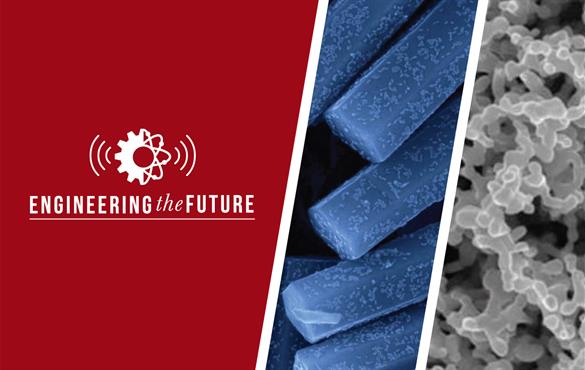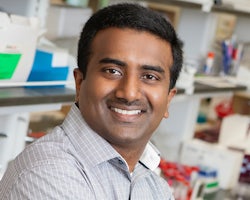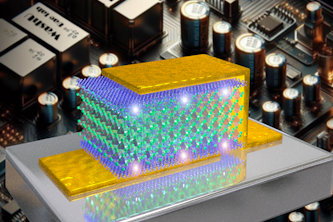Engineering the Future: Nanoparticles Part 1
This episode is all about nanoparticles: What are their properties, how are they formed and why should you care?

This is the second episode of Dean Aaron Bobick’s new podcast: Engineering the Future.
What is a nanoparticle? What properties do they possess to make them behave the way they do?
Transcript
From Washington University in St. Louis's School of Engineering and Applied Science, I'm your host Dean Aaron Bobick. And this is Engineering the Future, where we explore pressing problems of today in which engineering discovery, innovation and education can provide solutions for tomorrow.
This episode is actually the first of a three-part series that we'll be doing on nanoparticles. Now, if you're like me, you hear the prefix nano being used in all sorts of contexts, whenever someone wants to emphasize something being very small. Nanoseconds are a billionth of a second. The phrase nanofabrication involves making really tiny nanodevices, and those devices are sometimes called nanomachines. But today, we're going to focus on nanoparticles, really small particles that have some remarkable, and frankly, counter-intuitive properties. We'll first learn exactly what nanoparticles actually are, how they are formed, and why you should care. As you will hear, nanoparticles created incidentally by various industrial and energy systems can be insidious health hazards, causing both immediate and longer-term disease. But when cleverly designed and deployed, they can provide new materials with important applications in energy and environmental engineering, and perhaps, ironically, critical advances in medicine.
So let us begin. To help us understand the nature of nanoparticles, I am thrilled to be joined today by two of my WashU Engineering colleagues, Srikanth Singamaneni, Professor in the Mechanical Engineering and Material Science Department, and Rajan Chakrabarty, Assistant Professor in Energy, Environmental, and Chemical Engineering. Welcome to you both, and thank you for making time to help our audience understand about the power and the challenges of nanoparticles.
Thank you, Aaron, and thank you for having me on your podcast.
Thanks for having me.
All right. So let's start with the basics. In straightforward terms, what is a nanoparticle? Srikanth, let's start with you.
So let's start with what a nano is. As you briefly mentioned, a nano is basically referring to one billionth of something. And materials with at least one of the dimensions in the range of one to hundred nanometers are generally called as nanomaterials. It can be a spherical particle, with a diameter of one to hundred nanometers, or it can be a wire-like structure, where the length can be extremely long. It can be as long as few microns, but as long as the diameter of these wires is within one to hundred nanometers, we call them as nanowires. Or it can be sheet-like structures, where the lateral dimensions can be microns. But as long as the thickness, again, falls into one to hundred nanometers, we call them as nanosheets.
So a human hair is about 50 to 100 microns or so. And a micron is 1000 nanometers. So nanoparticles, you're saying, are on the order of 1000 to 10,000 times smaller than the thickness of a human hair?
Yes.
And I suppose that chemical importance and reaction could be both a good thing, for particles that we create, or maybe a bad thing for things like smoke and pollution, when those particles get into our lungs.
This particular property also influences the inhalation and deposition on human and animal system.
Has nature leveraged nanoparticles? Right? So as evolution leveraged the idea that if I've got an organism that can produce a nanoparticle, it can now do something that it couldn't do before.
Yeah, lotus leaf is an excellent example. The hydrophobicity, that is if you put a water drop on lotus leaf, it doesn't actually spread on the surface. It just rolls off of the surface. The reason is because not just simply because it has a waxy coating on the surface of the leaf, but because there is a nanostructured and microstructured surface to that lotus leaf, which causes these tiny air pockets to be present on this lotus leaf, which causes this superhydrophobicity.
We're going to talk about that next time because that's an engineered solution. It happens to be engineered by evolution, but it was not incidental. In some sense it's fundamental.
Right.
So that's really cool. All right. Let's continue on. So there are these incidental processes, where we have [i], whether it's natural or man-made, that tend to produce those particles. I'm going to assume that the particles that you get out from there are not really under your control.
Right.
All right. So if I want to produce particles that have certain properties, how do I go about doing that? And Srikanth, I think you do that in your lab all the time.
Right. We do that very routinely in our lab. Broadly speaking, there are two approaches to doing that, actually. Top-down and bottom-up processes. Top-down process is where you start with the bulk material, say, for example, bulk gold. If I cut that bulk gold into two pieces, hardly anything changes, actually. You see the same gold that we are all familiar with. But if we continue to cut this into smaller and smaller pieces, and finally when I reach, say, for example, 20 nanometers, 30 nanometer gold nanoparticle, now the particle absorption is very different. Their optical properties are very different. It is a function of size of the particle and the shape of the particle. In fact, actually, shape is a very convenient handle if you want to manipulate the optical properties of these particles.
So what I think I'm hearing you say is that in traditional, I guess what you call bulk materials, what something looks like is a function of what the stuff is. The molecules are actually present. But when they get this small, the way the light, the photons of light, interact with the material, it's now the shape and size of the particle-- not what the particle actually is, but the shape and the size that is determining what the optical reaction is going to be.
Composition is still important, but without changing the composition, I can change the color of these particles by changing only the shape of these particles.
Got it. So gold nanoparticles behave differently than silver nanoparticles, but gold nanoparticles of one size and shape behave differently than other gold particles of a different size and shape.
Exactly.
How do you actually go about cutting the material down so that you get nanoscale particles?
So we are using a beam of electrons in this case because we can really focus it down to nanoscale dimensions. We use these electron beam as our knives to be able to define these features on surfaces.
All right. So you can essentially make, if you will, markings. You can etch out--
Exactly.
--small particles from these materials.
Right.
Very good. All right, so that was top-down. What did you mean by bottom-up?
So the bottom-up approach is where you start with the atoms. And you are putting together these atoms to make the nanoscale structures. So here you're essentially starting with nothing, bringing the atoms together to form nanoparticles.
Where do you get atoms?
Okay. So for example, if I want to make a gold nanoparticle, I start with gold salt. It's remarkably similar to the common salt-- the table salt we all use, that is sodium chloride. Instead of starting with sodium chloride, I start with gold chloride. I dissolve gold chloride in water, of course. Any salt dissolves in water. So naturally I dissolve gold salt in water. And then I add a reducing agent to this salt solution. And that reducing agent causes these ions of gold to be reduced into atomic state and they start coming together to form these nanoparticles.
So basically, we're doing chemistry--
Right.
--to bring together enough atoms of gold to form a particle, and that particle is of nanoscale.
Right. Exactly.
All right, very good. So Rajan, in the past you and I have spoken a little bit about how just burning stuff, fire, causes smoke, which we all know. But then you told me that a component of that smoke is in fact, nanoparticles.
Yes, so fire is a classical problem. I mean, it has been studied for centuries. And to a visual-- visually, you've seen that it seems like-- okay, fire is a puff of gaseous emissions, or pollutants being emitted. But what is actually happening is initially, when you combust or you burn something, a fuel, you have gaseous products being emitted, which as the temperature cools down, you have the thermodynamically favorable conditions for phase change to take place from gas to liquid to solid. So that is the traditional, classical picture we know. But in the context of nanoparticles, the fire constitute a lot of-- it's a very charged environment, which means that when you have a charged environment, you have to take into consideration of the surface area of the pollutants. Since a gas molecule is extremely small, and you have these charges interacting with the surface area, so that will facilitate the phase change. And then what you see are emissions of solid nanoparticles from a fire.
Cool. So essentially, you have this complex interaction going on. You have this emission of gas, but as the temperature cools down, and as you have these various electrical charges at work, those charges cause the molecules to phase change to liquid and then into solid. And those solids can often be nanoparticle scale.
Yes. The property here controlling that is surface area, again.
And then what happens is things start to cool. And when it cools, we have all these electrical charges that are going to interact with these gas molecules to form these gaseous clusters, which have very high surface area, then become liquid, then become solid. And now you've got these clusters of solids with very high surface area, otherwise known as nanoparticles.
Let's just recap a little bit. Nanoparticles are really, really small - we said about a ten thousandth the width of a human hair - and not visible in a traditional microscope. And they're so small that they interact with the world in unusual ways. Rajan talked about that the ratio of the surface area to volume is so high that they are incredibly reactive to their chemical environment. And these-- reactivity is very important. But they don't have the mass that we typically assume agents to have, and so they behave differently, say, in the atmosphere. And Srikanth talked about how interacting with the light, it doesn't-- the materials don't even look the way they used to look like before.
What we're going to do next, they have two episodes that will continue this discussion about nanoparticles. First, we're going to examine the environmental challenges that they pose, in both terms of health and climate. And I hate to cast Rajan in the evil role, but frankly, Rajan's expertise on how these behave in the atmosphere and how these particles get produced will give us some insight as to the health environmental challenges there. That's the bad side, if you will.
But then we'll conclude with another episode about some of the remarkable developments that take advantage of the unusual properties of these particles, advances in health, energy, and materials. And we'll continue our conversation with Srikanth, who in his lab whips up this magic and makes these particles do things that really enable us to see things and do things that we've not been able to in the past. So stay tuned. Those will be up next.
Click on the topics below for more stories in those areas
- Research
- Dean's Podcast
- Energy, Environmental & Chemical Engineering
- Mechanical Engineering & Materials Science





